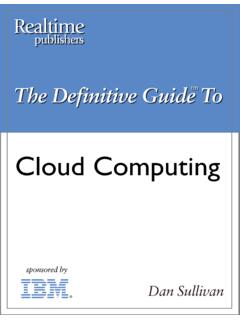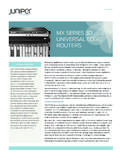Transcription of Fallacies of Distributed Computing Explained
1 Fallacies of Distributed Computing Explained (The more things change the more they stay the same). Arnon Rotem-Gal-Oz [This whitepaper is based on a series of blog posts that first appeared in Dr. Dobb's Portal ]. The software industry has been writing Distributed systems for several decades. Two examples include The US Department of Defense ARPANET (which eventually evolved into the Internet) which was established back in 1969 and the SWIFT protocol (used for money transfers) was also established in the same time frame [Britton2001]. Nevertheless, In 1994, Peter Deutsch, a sun fellow at the time, drafted 7. assumptions architects and designers of Distributed systems are likely to make, which prove wrong in the long run - resulting in all sorts of troubles and pains for the solution and architects who made the assumptions.
2 In 1997 James Gosling added another such fallacy [JDJ2004]. The assumptions are now collectively known as the "The 8. Fallacies of Distributed Computing " [Gosling]: 1. The network is reliable. 2. Latency is zero. 3. Bandwidth is infinite. 4. The network is secure. 5. Topology doesn't change. 6. There is one administrator. 7. Transport cost is zero. 8. The network is homogeneous. This whitepaper will looks at each of these Fallacies , explains them and checks their relevancy for Distributed systems today. The network is reliable The first fallacy is "The network is reliable." Why is this a fallacy? Well, when was the last time you saw a switch fail? After all, even basic switches these days have MTBFs (Mean Time Between Failure) in the 50,000 operating hours and more. For one, if your application is a mission critical 365x7 kind of application, you can just hit that failure--and Murphy will make sure it happens in the most inappropriate moment.
3 Nevertheless, most applications are not like that. So what's the problem? Well, there are plenty of problems: Power failures, someone trips on the network cord, all of a sudden clients connect wirelessly, and so on. If hardware isn't enough--the software can fail as well, and it does. The situation is more complicated if you collaborate with an external partner, such as an e-commerce application working with an external credit-card processing service. Their side of the connection is not under your direct control. Lastly there are security threats like DDOS. attacks and the like. What does that mean for your design? On the infrastructure side, you need to think about hardware and software redundancy and weigh the risks of failure versus the required investment. On the software side, you need to think about messages/calls getting lost whenever you send a message/make a call over the wire.
4 For one you can use a communication medium that supplies full reliable messaging; WebsphereMQ or MSMQ, for example. If you can't use one, prepare to retry, acknowledge important messages, identify/ignore duplicates (or use idempotent messages), reorder messages (or not depend on message order), verify message integrity, and so on. One note regarding WS-ReliableMessaging: The specification supports several levels of message guarantee--most once, at least once, exactly once and orders. You should remember though that it only takes care of delivering the message as long as the network nodes are up and ru n n in g , it d oesn 't h an d le p ersisten cy an d you still n eed to take care of that (or use a vendor solution that does that for you) for a complete solution. To sum up, the network is Unreliable and we as software architect/designers need to address that.
5 Latency is zero The second fallacy of Distributed Computing is the assumption that "Latency is Zero". Latency is how much time it takes for data to move from one place to another (versus bandwidth which is how much data we can transfer during that time). Latency can be relatively good on a LAN--but latency deteriorates quickly when you move to WAN. scenarios or internet scenarios. Latency is more problematic than bandwidth. Here's a quote from a post by Ingo Rammer on latency vs. Bandwidth [Ingo] that illustrates this: "B u t I th in k th at it's really interesting to see that the end-to-end bandwidth increased by 1468 times within the last 11 years while the latency (the time a single ping takes) has only been improved tenfold. If th is w ou ld n 't b e en ou g h , th ere is even a n atu ral cap on laten cy.
6 T h e minimum round-trip time between two points of this earth is determined by the maximum speed of information transmission: the speed of light. At roughly 300,000 kilometers per second ( * 10E12. teraangstrom per fortnight), it will always take at least 30 milliseconds to send a ping from Europe to the US and back, even if the processing would be done in real time.". You may think all is okay if you only deploy your application on LANs. However even when you work on a LAN with Gigabit Ethernet you should still bear in mind that the latency is much bigger then accessing local memory Assuming the latency is zero you can be easily tempted to assume making a call over the wire is almost like making a local calls--this is one of the problems with approaches like Distributed objects, that provide "network transparency"--alluring you to make a lot of fine grained calls to objects which are actually remote and expensive (relatively) to call to.
7 Taking latency into consideration means you should strive to make as few as possible calls and assuming you have enough bandwidth (which will talk about next time) you'd want to move as much data out in each of this calls. There is a nice example illustrating the latency problem and what was done to solve it in Windows Explorer in Another example is AJAX. The AJAX approach allows for using the dead time the users spend digesting data to retrieve more data - however, you still need to consider latency. Let's say you are working on a new shiny AJAX front-end--everything looks just fine in your testing environment. It also shines in your staging environment passing the load tests with flying colors. The application can still fail miserably on the production environment if you fail to test for latency problems-- retrieving data in the background is good but if you can't do that fast enough the application would still stagger and will be unrespon sive.
8 (You can read more on AJAX and latency here.) [RichUI]. You can (and should) use tools like Shunra Virtual Enterprise, Opnet Modeler and many others to simulate network conditions and understand system behavior thus avoiding failure in the production system. Bandwidth is infinite The next Distributed Computing Fallacy is "Bandwidth Is Infinite." This fallacy, in my opinion, is not as strong as the others. If there is one thing that is constantly getting better in relation to networks it is bandwidth. However, there are two forces at work to keep this assumption a fallacy. One is that while the bandwidth grows, so does the amount of information we try to squeeze through it. VoIP, videos, and IPTV are some of the newer applications that take up bandwidth. Downloads, richer UIs, and reliance on verbose formats (XML) are also at work-- especially if you are using T1 or lower lines.
9 However, even when you think that this 10 Gbit Ethernet would be more than enough, you may be hit with more than 3 Terabytes of new data per day (numbers from an actual project). The other force at work to lower bandwidth is packet loss (along with frame size). This quote which underscores this point very well: "In the local area network or campus environment, rtt and packet loss are both usually small enough that factors other than the above equation set your performance limit ( raw available link bandwidths, packet forwarding speeds, host CPU. limitations, etc.). In the WAN however, rtt and packet loss are often rather large and something that the end systems can not control. Thus their only hope for improved performance in the wide area is to use larger packet sizes. Let's take an example: New York to Los Angeles.
10 Round Trip Time (rtt) is about 40 msec, and let's say packet loss is ( ). With an MTU of 1500 bytes (MSS of 1460), TCP. throughput will have an upper bound of about Mbps! And no, that is not a window size limitation, but rather one based on TCP's ability to detect and recover from congestion (loss). With 9000 byte frames, TCP throughput could reach about 40 Mbps. Or let's look at that example in terms of packet loss rates. Same round trip time, but let's say we want to achieve a throughput of 500 Mbps (half a "gigabit"). To do that with 9000 byte frames, we would need a packet loss rate of no more than 1x10^-5. With 1500 byte frames, the required packet loss rate is down to ^-7! While the jumbo frame is only 6 times larger, it allows us the same throughput in the face of 36 times more packet loss." [WareOnEarth].






